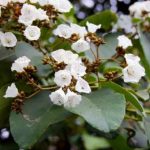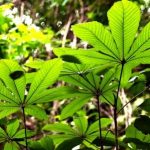TREE LIFE
September 2003
WHILE THE CURRENT FUEL CRISIS PERSISTS IT IS IMPORTANT TO CONFIRM WITH ANY OF THE COMMITTEE MEMBERS THAT THE SCHEDULED OUTINGS AND WALKS CAN ACTUALLY TAKE PLACE. SEE THE BACK PAGE FOR PHONE NUMBERS.
MASHONALAND CALENDAR
Saturday 6th September. Botanic Garden Walk. We hope that in Tom’s absence Meg will step in to lead the walk. Meet in the car park at 10.45 for 11am.
13th – 14th September. Tree & Grasses Identification week-end at Hwange. See July Tree Life for details.
Sunday 21st September. Our outing to Mitchell & Mitchell in Marondera will be something rather different from our normal Tree Society outings.
Mitchell & Mitchell is one of the biggest vegetable growers in the country and the complex is huge with its own water re-cycling system and many other innovative procedures. Mrs Jenny Mitchell has kindly offered to show us around.
We will meet at 9.30 am. Bring your lunch and a chair.
Saturday 27th September. Mark’s Walk will be at Thetford Estate in Mazowe. Please phone Mark on 745263 for directions and other details.
Tuesday 7th October. Botanic Garden Walk
MATABELELAND CALENDAR
Nothing has been arranged for September.
BOTANIC GARDEN WALK: 2 August 2003
With Tom away in the UK, Meg Coates Palgrave kindly stepped in to take our Botanic Garden walk. The subject was “South African Trees“.
Our first stop was at a Ficus sycomorus, a tree of lower altitudes which likes damp sites. Its distinctive horizontal branches would make it the ideal candidate for Zacchaeus of biblical fame to have climbed. This should not be confused with the European sycamore or the abundant Ficus carica. Meg explained how the normal method of pollination involved the specific wasp for that fig finding a fig, entering and pollinating the interior anthers, laying eggs and dying. The larvae hatch, pupate and the female is fertilised by the male before she picks up pollen from the style and forces an exit. The atmosphere which has become very rich in carbon dioxide due to all this activity is thus normalized and the fig begins to ripen. Also in a biblical context she speculated that this was the role of “Amos (nipper of figs)” – in the absence of the specific wasp for Ficus sycomorus his job was to put holes in the figs allowing oxygen to enter and the fig to ripen.
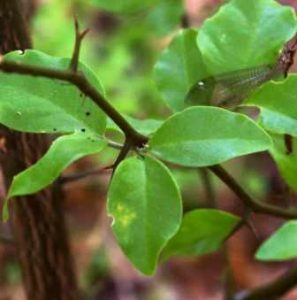
Balanites maughamii. Photo: Meg Coates Palgrave. Source: Flora of Zimbabwe
The multi-trunked Balanites maughamii is also found in the lowveld although it does like water. This fast-growing species has a very distinctive small bifoliolate leaf. This type of compound leaf is rare in our flora – only a few other plants, for example the mopane and the two species of Guibourtia, have this feature.
Near the Herbarium, we passed the grove of raffia palms (Raphia farinifera) with their enormous leaves coming from the base of the trunk. It was noted that a different but quite closely-related species occurs in South Africa.
Rising from the lowveld into wet montane forests, we might see the bright orange flowers on the stem of Halleria lucida. Meg remarked that flowering on the stem is referred to as cauliflory.
Meg also took this opportunity to explain that leaves came in 3 basic shapes – oval (usually known as elliptic or elliptical in the botanical literature), ovate and obovate depending on the bulge .
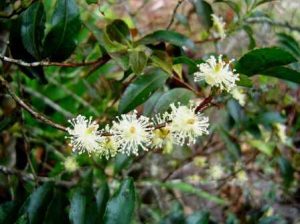
Aphloia theiformis. Photo: Bart Wursten. Source: Flora of Zimbabwe
In montane habitats, the white flowers and berries of Aphloia theiformis – the albino berry, should catch the eye. As most white flowers and berries are designed to be seen at night, the pollinators are likely to be bats and moths, although in this case the habitat makes the blue duiker a likely candidate for the job.
In wet riverine habitats we might find Ilex mitis – the African holly. While not as prickly as its European counterpart (only some of the leaves have a single small prickle) the purple grooved petiole was very distinctive. Like the European version it is also dioecious, bearing different sexes on different trees.
Two species of Podocarpus were compared. Podocarpus latifolius, which occurs in our Eastern Districts and also widely in South Africa, has larger, darker-green leaves (more or less the texture of plastic) and each fruit bears a large, coloured, fleshy receptacle at the base. Podocarpus falcatus, a purely South African species, lacks the receptacle and for that reason has been placed in a separate genus, Afrocarpus.
Up to now, most of the species had been more or less familiar as they occur in Zimbabwe as well as South Africa. We then moved on to more specifically S African species.
Atalaya alata was a new species to me (MAH) but also a very distinctive one. It has compound leaves which are 1-pinnate and the leaflets are oblique at the base. This arrangement is very similar to Zanha africana and also to the various planted Sapindus species which we see around Harare. It was therefore interesting to note that all these 3 genera belong to the same family, namely the Sapindaceae. However, Atalaya alata has a further very striking feature – the fruit is a 3-winged nut. The species occurs in coastal scrub forest.
Hibiscus tiliaceus (the coast hibiscus) is a large bushy shrub or small tree, “often fringing estuaries and tidal rivers” – per Coates Palgrave, edition 3. The leaves are large and relatively broad, indeed almost circular and have a deeply lobed base with the lobes overlapping. I presume that the specific name refers to the Tilia species (lime trees) of Europe which have similar almost circular leaves.
On past Combretum kraussii (the forest bushwillow). This tree, rather like our Combretum obovatum, has young leaves which are white-streaked so that the whole tree appears to be covered in white flowers. The actual flowers themselves are insignificant. (This is a bit like the Bougainvillaea, which has similar striking coloured bracts and insignificant flowers). A further feature is that its leaves then turn red before they fall. C. kraussii is a widespread species in South Africa but does not reach Zimbabwe.
Vepris lanceolata (was Vepris undulata) is a species of “white ironwood”. It is a typical Rutaceae in that it has translucent gland dots in the leaf lamina and these glands give the leaf a characteristic aroma when crushed. This is a species of evergreen forest, again strictly south of the Limpopo.
Millettia grandis is a legume (subfamily Papilionoideae) with beautiful purple to mauve flowers and velvet-hairy pods. Again, it is not Zimbabwean but it is occasionally planted in gardens here – for example there is a medium-sized specimen in College Road, Alexandra Park which can be easily seen from the road. In its native habitat it is a coastal species occurring within 20 kilometres of the coast.
Finally, we looked at Ocotea bullata, the stinkwood. This is a forest species attaining 30 metres. Its wood is very much in demand and even in the 1800s the wood was already being over-exploited. Now it is the subject of protection. It is a forest pioneer species. The leaves are simple and have domatia in the leaf axils.
Our great thanks go to Meg for an exceptionally interesting walk.
-Linda Hyde and Mark Hyde
??THE GONDWANALAND CONNEXION???
In 1981 I had a 7-week visit to Australia, primarily to attend an international conference in Canberra, but also to tour the forest and woodland areas to try to see what additional species might be worth introducing into Zimbabwe, especially for use in the drier parts of the country. A major part of the brief was to make personal contact with the various forest research organizations with a view to securing supplies of the seed that we wanted to introduce. In the course of this visit I was able to get a broad overview of the Australian vegetation, and was struck by the number of genera Zimbabwe has in common with northern Australia. In a number of cases there was no problem in recognizing the genus immediately.
The vegetation of Australia is too vast a subject for treatment in any detail in a note of this nature, and only a broad outline can be given here. Following the breakup of ancient Gondwanaland Australia was subjected to a series of major climatic changes during the gradual drift to its present-day geographical location. These climatic changes, which appear sometimes to have followed rapidly on one another, had an immense impact on what was once a comparatively uniform vegetation, causing destruction, modification, and migration of species and communities. In spite of all these changes, and the evolution and speciation that has taken place over millions of years, resulting in a typically Australian vegetation in which the majority of species originated in, and are confined to, that continent, there still exist many links with the southern African flora. The family Proteaceae, for example, is particularly well represented in both regions.
A partial list of genera (by families), and occasionally of species (marked *), common to northern Australia and Zimbabwe appears below, and shows some of the links in the vegetation of the two countries.
ANACARDIACEAE Rhus
ANNONACEAE – Uvaria, Xylopia
APOCYNACEAE – Carissa
ARALIACEAE – Polyscias, Schefflera
BOMBACACEAE –Adansonia
BORAGINACEAE –Cordia, Ehretia
CAPPARACEAE – Capparis
CELASTRACEAE –Maytenus
CELTIDACEAE –Celtis, Trema
CHRYSOBALANACEAE –Parinari
CLUSIACEAE – Garcinia
COMBRETACEAE – Terminalia
CONVOLVULACEAE – Ipomoea
DICHAPETALACEAE – Dichapetalum
EBENACEAE – Diospyros
ERYTHROXYLACEAE – Erythroxylum
EUPHORBIACEAE – Antidesma, Bridelia, Cleistanthus, Croton, Drypetes,Euphorbia, Excoecaria, Macaranga, Phyllanthus
FLACOURTIACEAE – Casearia, Homalium, Scolopia
HERNANDIACEAE – Gyrocarpus americanus*
ICACINACEAE – Apodytes
LAMIACEAE – Clerodendrum, Vitex
LAURACEAE – Cryptocarya
LEGUMINOSAE – Acacia, Abrus, Albizia, Caesalpinia, Cassia, Crotalaria, Entada, Erythrina, Erythrophleum, Indigofera, Mucuna, Peltophorum, Sophora
MALVACEAE – Hibiscus
MELIACEAE – Turraea
MORACEAE – Ficus
MYRSINACEAE – Maesa, Myrsine
MYRTACEAE – Eugenia, Syzygium
OLEACEAE – Linociera
OLACACEAE – Ximenia americana*
PHYTOLACCACEAE – Phytolacca
PIPERACEAE – Piper
PITTOSPORACEAE – Pittosporum
PODOCARPACEAE – Podocarpus
RANUNCULACEAE – Clematis
RHAMNACEAE – Ziziphus
ROSACEAE – Prunus, Rubus
RUBIACEAE – Canthium, Gardenia, Pavetta, Tarenna
RUTACEAE – Clausena
SAPINDACEAE – Dodonaea viscosa*
SAPOTACEAE – Chrysophyllum, Mimusops
SMILACACEAE – Smilax
SOLANACEAE – Solanum
STERCULIACEAE – Sterculia
STRYCHNACEAE – Strychnos
TILIACEAE – Grewia, Triumfetta
-Lyn Mullin
ARCTURUS: 20 JULY 2003
Darryl Tiran’s place near Arcturus was the venue for our third Sunday July outing. Following the instructions on how to get there we climbed ever higher up into some hills before coming out in an open area at the end of the road. From there was a view over rolling hills.
The altitude was not actually all that high: 1430 metres by my GPS. All around us was miombo woodland, which had all been cleared many years ago and had re-grown. We were joined by a number of guests and it was a relatively large group that descended along the path through the woodland.
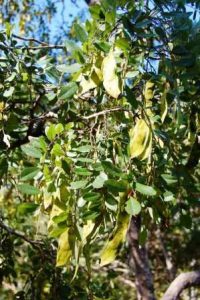
Pericopsis angolensis. Photo: Stefaan Dondeyne. Source: Flora of Zimbabwe
One of the first trees we saw was the muwanga, Pericopsis angolensis. I always tend to think of this as occurring at lower altitudes but as we know from places north of Harare it does occur in the hills there and you don’t need to go much below Harare’s altitudes to find it coming in as it did here. Usually recognised by the pale whitish bark, the 1-pinnate leaves with leaflets which are alternate and (if they are present) the flattened and winged pods.
The Tree Society jokes that this species always has a dead branch on the left hand side. Although the left-hand element of this is clearly ridiculous, the feature of having dead branches does seem to have some element of truth. I would be interested in other people’s comments in this.
As it was mid-winter (of the warm Zimbabwean variety) there was not much in the way of herbs or shrubs actually in flower. However, those that were were often compositae (Asteraceae). This family often flowers late in the season and runs on into the winter.
Examples of compositae seen were:
Blumea crispata: a very sticky plant in all its parts with striking winged stems and nodding flower heads. It appears a good native in open miombo woodland (as here) but seems to have found a niche as a weed of open weedy situations in Harare as well. The flowers, which are a purplish colour, were seen on this day.
Crassocephalum rubens: a thistle-like plant with blue or red flowers. Not specifically winter-flowering, this happened to have persisted into the dry season.
Inula glomerata : this is a stout woodland herb which bears yellow flowers in clusters. The leaves are large and taper to a point at the apex. It is a very common and distinctive plant which we often see round Harare.
Vernonia myriantha: this is the most striking vernonia with its large flattish flower heads of purple or pale purple flowers. It also has very striking large pseudo-stipules but these have generally fallen off by the time the species flowers. Again, this tends to be winter-flowering. Another composite seen in flower was Vernonia adoensis (another large herbaceous vernonia).
As we descended, the woodland we saw Pittosporum viridiflorum, Faurea rochetiana, Gardenia ternifolia (the “tongue test”) was used to verify this and Uapaca kirkiana. After a time we split naturally into two groups, one led by me and one by Meg Coates Palgrave, which made the group more manageable.
After a time we came to some dumped heaps of soil which had been colonised predominately by two species: the castor-oil plant (Ricinus communis) and a tall species of Sesbania. The Ricinus was flowering and one could see the male flowers at the top of each inflorescence and the female flowers, which become spiny-fruits when mature, below.
We passed a colony of Acacia polyacantha which were mostly leafless at this stage but were recognisable by their hooked thorns and the white trunks and branches. We also saw a single Acacia goetzei.
Eventually the track reached a small valley and the road ran along beside a flowing stream. This was probably the most interesting area of the day. Here were some typical trees of wet places, such as the river combretum, Combretum erythrophyllum and the lanceleaf waxberry, Morella serrata. The latter has golden glands all over the underside of the leaf.
Some specimens of Salix mucronata were also seen; again, this is a typical plant of wet places as also is the river rhus, Rhus quartiniana. Large trees of Syzygium cordatum with their greyish sessile clasping leaves were also seen.
Some large specimens of Pterocarpus rotundifolius were there as well smaller shrubs such as Euclea crispa and Catha edulis.
As is often the case by streams near to Harare there was also a fine crop of alien species, of which the following were the most prominent: Toona ciliata, (very distinctive with its large 1-pinnate leaves), Jacaranda mimosifolia (2-pinnate, yellowish leaves), Casimiroa edulis (only one of these seen, it is not particularly invasive; it has palmate leaves with pellucid glands). And also, thick, thick patches of Lantana. Also present was an exotic climbing Passiflora, namely Passiflora subpeltata. This is a garden escape with white flowers, spherical fruits and exceptionally large stipules.
We then walked back up the hill to the cars for a late lunch. After lunch, no-one had any energy for further treeing and the outing broke up at that point.
Thank you, Darryl, for allowing us to come to your plot and also to Kevin Fallon; we hope to return at a different time of year.
-Mark Hyde
THE WIDE-RANGING GENUS DIOSPYROS
The genus Diospyros (Ebenaceae) is a very large one, containing around 475 species of trees and woody shrubs, among them some important timber and fruit trees – the true ebonies and the persimmons. According to DJ Mabberley (1993) The Plant-Book, there are about 80 species in North America, 94 species in Africa, 100 in Madagascar, and 200 in Asia. Zimbabwe has 13-14 of the African species, and it is pleasing to see that Diospyros nummularia has been re-instated as an independent species in Coates Palgrave (2002) Trees of Southern Africa, bringing it back to where it was when I first came across it in 1951.
The name Diospyros comes from the Greek, and I have always understood it to mean ‘divine pear’, in allusion to the delicious fruits of some species. Coates Palgrave has it “freely translated” as ‘celestial pear’, which amounts to the same thing, but I have difficulty in getting to grips with the ‘divine wheat’ of R.B. Drummond (1981) Common Trees of the Central Watershed Woodlands of Zimbabwe and Elsa Pooley (1993) The Complete Field Guide to Trees of Natal, Zululand & Transkei.
The timber species of Diospyros include D. ebenum (Ceylon ebony) from India and Sri Lanka, often mentioned in the classical tales of ancient Persia, and possibly (not probably) the ebony of the Bible (Ezekiel 27:15)*; D. crassiflora and D. piscatoria (African ebony) from tropical Africa; D. celebica (Macassar ebony) from the Celebes Islands (now Saluwesi) in Indonesia; D. marmorata (Andaman marblewood) and D. oocarpa (calamander or Coromandel wood) from the Andaman Islands of India; D. montana (Bombay ebony) from Indo-malaysia; D. haplostylis (Madagascar ebony) from Madagascar; D. reticulata (Mauritius ebony) from Mauritius; and D. virginiana (persimmon) from the United States. In the case of the last-named species the larger trees on the poorer sites are economically valueless because they contain a high percentage of heartwood that cracks excessively during seasoning.
*[The ebony of the Bible could, in fact, be Dalbergia melanoxylon]
Most of these timbers are very heavy, ranging from 1030 kg/m to 1190 kg/m (70-74 lb/cu.ft), but the wood of D. virginiana is a fair bit lighter at 850 kg/m (53 lb/cu.ft), i.e. the same weight as our own D. mespiliformis (African ebony or jackalberry).
Of the 13 or so species of Diospyros that are indigenous in Zimbabwe only one has a genuine, ebony-black timber. This is D. quiloensis from the low-lying areas of the north and northwest, and the southeast. In 1956, when I was seconded from the Forestry Commission for bush-clearing experiments in the Kariba area, I cut several of these trees in the vicinity of the Nyanyana River, close to the present-day crocodile farm, and all of them had a very narrow band of yellowish-white sapwood and a large black heartwood. The species does not reach large sizes (10 m tall and diameters up to 30 cm at best), so trying to harvest ‘ebony’ from them would not be very rewarding, but I have always regretted that I did not keep a few specimens. In most of our other species of Diospyros the heartwood and sapwood are largely undifferentiated, but D. senensis (spiny jackalberry) from the Zambezi Valley does have a distinct, red-brown heartwood. It is too small, though, to be of any commercial value.
Among the important fruit-bearing species in the genus are D. virginiana (persimmon), which occurs widely in the southeastern United States from southern Connecticut and Long Island to southern Florida, westward to southeastern Iowa, and southward to eastern Texas; D. kaki (kaki, or Chinese, Japanese, or oriental persimmon), which is cultivated in many tropical countries;
- blancoi(mabola) from central Malesia**; D. digyna(black sapote) from Central America; and
- lotus(date plum) from China and Japan to western Asia).
**[Malesia = Timor and other Lesser Sunda Islands; Saluwesi; New Guinea; New Britain; and Mindanao in the southern Philppines]
The fruits of our own D. mespiliformis are quite good eating, and those of D. kirkii are very tasty. D. squarrosa also has pleasant, edible fruit, but one should obviously exercise a bit of caution with other species because at least one Diospyros in South Africa is said to have poisonous fruits.
Two Diospyros species have unusual uses. The leaves of D. melanoxylon from India and Sri Lanka have been used as cigarette papers; and the sticky fruits of D. malabarica (gaub) from tropical Asia have been used for caulking boats.
The English common name “African ebony” for D. mespiliformis should really be discouraged because it conflicts with the well-established trade name for the wood of D. crassiflora and D. piscatoria from elsewhere in tropical Africa; in any case it produces no more than a pink-brown heartwood that may occasionally have a black streak in it. The name “jackalberry” (for D. mespiliformis), which has come to us from South Africa, derives from the occasional presence of fruits of this species in the stomach contents of jackals-no more than 1% of the wild fruits found in the stomachs of 71 side-striped jackals were identified as those of D.mespiliformis (see Skinner & Smithers, 1990, The Mammals of the Southern African Subregion), and I hope any South Africans who might read this note will forgive me if I say that it seems to me someone was really scratching for an English name for the tree! It might be added that other identifiable fruits from these same stomach contents were Ficus spp 10%; Parinari curatellifolia 6%, Uapaca kirkiana 1%, Solanum spp 1%, and Grewia spp 1%. Any of these could also have been dubbed “jackalberry”.
My own inclination for an English name for D. mespiliformis would be to adopt the Central Shona mushuma, which is common to all four of the main dialects, also to the Tonga language, and with slight variation to the Western Shona language.
-Lyn Mullin
In addition to the reference works cited in the text, the following publications were also consulted:
Bayard Hora (Consultant Editor) (1986). The Oxford Encyclopaedia of Trees of the World. Peerage Books, London.
H.A. Fowells (1965). Silvics of Forest Trees of the United States. U.S. Forest Service.
In Retrospect (Cont.) Lyn Mullin
MORE ON THE BIG FROST OF JUNE 1968
In TREE LIFE No.133 (March 1991) there was an interesting article by M.R. Izzet under the title “Notes on the Big Frost of 13.6.1968”. There was no indication that this was in response to George Hall’s appeal in TREE LIFE No. 127 (September 1990) for more information on the big frost, so it has taken its place in the chronological sequence of this series of extracts from earlier numbers of TREE LIFE.
These notes were made on trees on and adjacent to the Muunzi smallholding at the end of Stoneridge Road, turning off the Beatrice Road at the 8-mile peg. The area is on granite sandveld, and the water supply is about 20 feet below the surface. Granite outcrops occur on Muunzi. The tree growth in the area is good, and there are many large msasa trees. The land lies a quarter of a mile from the Hunyani River, on the west bank. (Since 1968 a bridge has been built over the river, leading to Chitungwiza.)
Notes in May 1968: During the month sprays of leaves began to turn yellow on Pterocarpus angolensis [mukwa], Burkea africana [mukarati], and Monotes, as usual. Brachystegia very green; the weather has been warm up to the end of the month. The last rain was in April. No sign of frost yet.
Notes in June 1968: On the night of 13th there was, without any warning, a terrible frost. The verandah thermometer, facing south, at 6.30 am read 34 degrees Fahrenheit. Much damage had evidently been done to trees, but the full extent became visible after three days. The temperatures at night on the 14th, 15th, and 16th were all below freezing.
Once the leaves had begun to dry one could see how terrible was the damage. The only tree that appeared to have withstood the frost was Faurea saligna, and even on some of these the leaves were shrivelled. Everything else, even to the tops of the largest msasas, looked as though it had been in a fire, except that the leaves were still there. Occasionally one found a small shrub that had been sheltered by the larger trees, and had not suffered so much damage. On the whole, however, the general appearance of the bush was the colouring of brown and grey. One could snap a twig off, with its dead leaves, and work back along the branch until the wood was as thick as one’s finger, and the material was still dead.
August 1968: During the first week of August a few sprays of leaves had begun to appear on a medium-sized msasa in the garden. The new leaves stood out amongst the dead foliage – it was very noticeable that the dead leaves did not fall from the trees, mostly clinging tenaciously to the dead twigs, particularly on the msasas. I suppose that being killed suddenly by the frost, together with the twigs and branches in many cases, there was no operation of the normal `leaf-drop’ mechanism.
By the end of August, as the weather began to warm up slightly, more new leaves began to appear, all very pale, and scattered in bunches here and there on the trees, particularly on the msasas, where the new growth often came directly out of the main trunk. The uppermost branches of the tall trees were in most cases completely dead, and later I noted that it took almost three years for this dead wood to disappear – and then not all of it vanished.
I cannot say that the following happened to all the frozen trees, but I saw it on the msasa, because they were before my eyes always around the garden.
The trees put out long shoots, a metre or more in length, and often from the main trunk of the tree, with huge leaflets on them. These shoots were actually gigantic twigs, and they hung weeping-willow fashion, making the trees look quite unlike their normal selves. I measured one leaflet, and it was 14 cm in length. Flower buds did appear on these twigs, but there was not a very good crop of pods. The growth was an impressive demonstration of nature’s resources for survival.
Another casualty, though not among the trees, was the cocoons of the large moth [Pachymeta robusta] that lays its eggs on the msasa trees. The eggs hatch and the caterpillars feed on the leaves, resting by day on the undersides of the larger branches. When the first chill of winter comes the larvae spin their cocoons on the undersides of the branches, and remain there throughout the winter. When the first rains come the moths emerge from the cocoons, and fly at night. For this reason they are not often seen, but they must come out in large numbers. These caterpillars are a familiar sight on the msasas, being large, up to eight centimetres or more when full grown, yellow in colour, and covered in long hairs that sting the fingers if handled. After the great frost we did not see any of these caterpillars for three years.
*****
And another Tree Society member – Ruth Evans recalls
“I well remember the whole Penhalonga valley being quite black as seen from the main road to Christmas Pass. My mom noted that mountain acacias in Waterfalls had also been burnt. Hibiscus hedges in Mabelreign were destroyed and had to grow again.”
MARK HYDE CHAIRMAN


